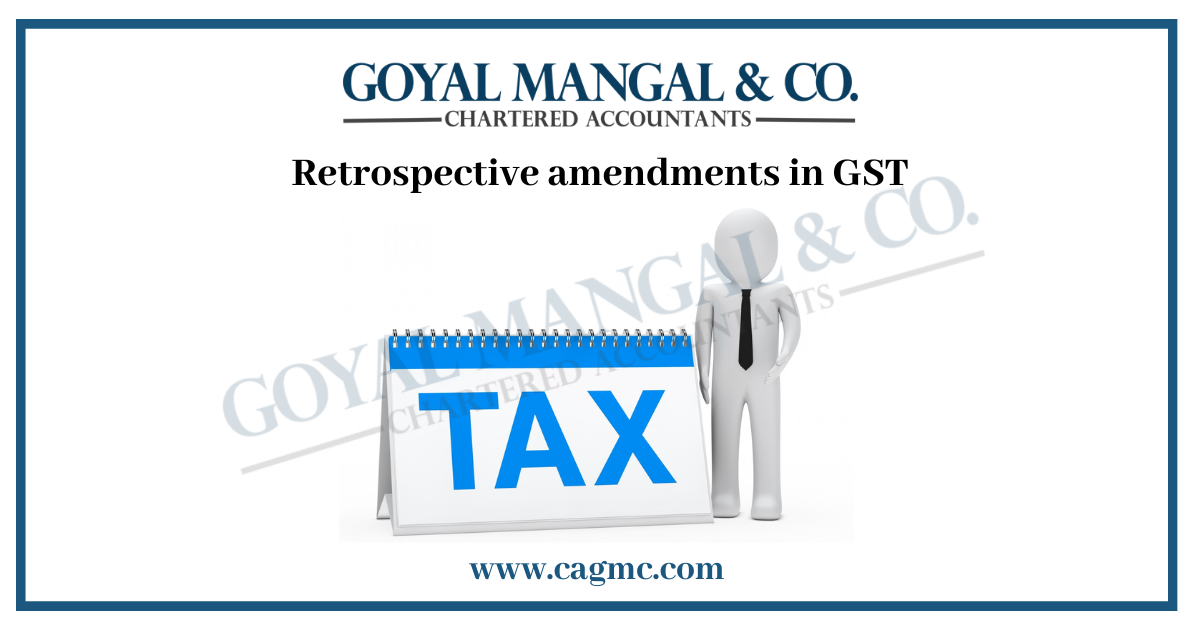
Imagine the rules of a game changing in the middle of play, and suddenly things you did before are against the rules! That’s kind of what happens with retrospective amendments in GST. These are changes to the tax law that apply not just to future transactions, but also to things businesses and people did in the past, sometimes years ago. In this blog we will get to know about the retrospective GST amendments and its impact.
| Table of Contents |
Overview
It is widely known that the government has the authority to modify sections of the GST law, which is of CGST, SGST or IGST especially those concerning taxes, with retrospective effect. So, people must know the meaning of retrospective tax that is applicable from past dates. Laws that amend previous legislation have also been subject to legal examination. The Vodafone-Hutchison case serves as a clear illustration of this. Retrospective changes are commonly made to eliminate uncertainties and provide greater clarity, or to conform with or overcome the rulings of the Supreme Court (SC), High Courts (HC), or Tax Tribunals concerning a specific matter. So there are various amendment takes place every year in GST, we just have to see the impact it will have in our business.

Types of Retrospective Amendments
There are two cases where an amendment to a law can be effective from a retrospective date.
- First, when the Amended Act explicitly states that a specific provision or provisions of the law will be changed retrospectively.
- Second, when the amendment includes an explanatory statement that starts with the phrase ‘For removal of doubts,’ implying that it is meant to clarify the law and therefore can be applied retrospectively.
- It is an established legal principle that, regardless of any other circumstances, in order for an amendment to have retroactive effect, it must be of a clarifying nature. However, if the amendment is causing significant changes in the law or negatively impacting taxpayers, it has been determined to have a prospective nature.
Retrospective powers under GST
- Even under the GST Law, there are certain authorities to issue notifications or include explanations that have a retrospective impact. If we carefully examine the terms of Section 168A (2) of the CGST Act, The power to issue notifications for extending time limits due to force majeure, as mentioned in sub-section (1), has been granted by the government to the entity, allowing the notification to have retrospective effect from the date the Act started, but not earlier.
- In the same way, Section 11 of the CGST Act grants the government the authority to waive taxes and issue notifications or orders as deemed necessary. Additionally, it grants the authority to add a clarification to the aforementioned notification or order within one year of its issuance, through notification. This clarification will be retroactively considered as an integral part of the initial notification or order.
- Section 164 grants authority to create regulations in order to implement the stipulations of the CGST Act, while sub-section (3) of the aforementioned Section allows for the application of these regulations retrospectively, starting from a date no earlier than the commencement of the CGST Act.
Case Study
Let’s delve into the amendments made in Section 102, Section 50, and Section 50(3) of CGST Act 2017, and amendments wants to be forces upon people retrospectively. Retrospective tax examples are:
- Remember how “goods, money, and securities” were originally excluded from the definition of “services” under the CGST Act? Things got interesting with “money,” where specific activities made it taxable, but “securities” remained in a vague zone. No one questioned their exclusion, no court judgments raised red flags, and there weren’t even conflicting interpretations needing clarification.
- Yet, a Board Circular threw a decision claiming “lending of securities” as a taxable service, retrospectively! This move, without any evidence of prior ambiguity, understandably feels unfair.
- On the other hand, the explanation added to the Act regarding “facilitating or arranging transactions in securities” seems like a genuine change – bringing a new activity under the “services” subject to GST.
- But it’s a rule that explanations usually clarify existing provisions, and those impacting taxpayers negatively should only apply prospectively. This explanation, however, imposes new tax burdens – a convincing argument against its retrospective application.
- So, while “lending of securities” seems like a genuine explanation, the explanation introducing “facilitating or arranging transactions” appears like a policy shift, deserving prospective application from 1.2.2019 onwards and not the retrospective effect.
- Retrospective amendment on section 50 of CGST Act that is Interest on delayed payment of tax takes place. Section 50 of CGST Act amendment notification came out that now, interest on late GST payments is calculated only on the money actually paid out (net cash), not the total tax amount. This applies to transactions all the way back to July 2017. Be aware of this new rule when filing your returns!
- Retrospective amendment has been made to section 50(3) of GST A new rule applies retroactively (from July 2017) saying you only owe interest on wrongly claimed tax benefits (input tax credit) if you actually used them. This means less unexpected charges for businesses but be sure to check your past filings and update accordingly.
Takeaway
In conclusion, the dynamics of retrospective amendments in GST underscore the need for a balanced approach that considers both revenue requirements and the interests of taxpayers. Striking this balance is essential to maintain a fair and transparent tax system, fostering trust and compliance. As governments continue to refine tax policies, it remains imperative to ensure that changes are well-communicated, provide clarity, and promote economic growth without overly burdening businesses.


